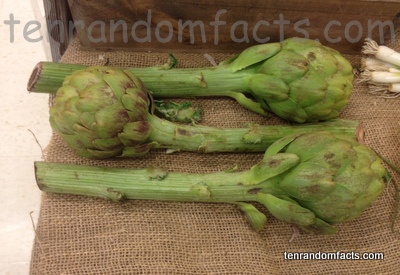Artichokes are somewhat a misnomer, though they will certainly choke you if they are swallowed whole!
- Artichokes are the edible flower buds of a perennial thistle plant, native to the Mediterranean region in Europe, and they are generally considered a vegetable, and eaten as such.
- The artichoke plant, also known as ‘globe artichoke’, has the scientific name Cynara scolymus and it is from the family Asteraceae, the family of daisies and asters.
- The rough spherical shape of artichokes is constructed with scales that somewhat resemble diamond shapes, each of which are generally armed with a thorn on the tip.
- The diameter of artichokes varies between 6 to 14 centimetres (2.4 to 5.5 inches), while the vegetable grows on plants that can reach 1.4 to 2 metres (4.6 to 6.6 feet) in height.
- The colour of artichokes ranges from green to purple to a mix of both, depending on the variety, and they need to be picked before they flower, because they will become inedible.
- Egypt was the largest producer of artichokes in 2012, with 387,704 tonnes (427,370 tons) of the world total of 1,634,219 tonnes (1.8 million tons), while Italy was not far behind with 364,871 tonnes (402,201 tons).
- Artichokes are cooked generally by boiling or steaming, although they can also be baked, grilled and microwaved, and they are popularly eaten with other vegetables or meat, while the scales are often dipped in a sauce or butter.
- The term ‘artichoke’ comes from the Northern Italian word ‘articiocco’, and originally from the Arabic ‘al-karšūfa’; and the vegetable has been cultivated for thousands of years.
- Generally artichokes are prepared by snipping off the thorns, and after cooking, the flesh from the scales can be pulled off with one’s teeth, the internal ‘choke’ removed and discarded, and the stalk and internal heart can be readily eaten and are said to be the tastiest sections.
- Artichokes are very high in fibre, antioxidants, folate and vitamin K, and they contain many other vitamins and minerals.
Bibliography:
Artichoke, 2015, Wikipedia, https://en.wikipedia.org/wiki/Artichoke
Artichoke Nutrition Facts, 2015, Nutrition-and-You, http://www.nutrition-and-you.com/artichoke.html
Steele M, How To Use Artichoke, 2015, Jamie Oliver, http://www.jamieoliver.com/news-and-features/features/how-to-use-artichoke/#L3MgDid5A9S9Yb3t.97







